
Hornblende is a complex inosilicate series of minerals. It is not a recognized mineral in its own right, but the name is used as a general or field term, to refer to a dark amphibole. Hornblende minerals are common in igneous and metamorphic rocks.

Magnetite is a mineral and one of the main iron ores, with the chemical formula Fe2+Fe3+2O4. It is one of the oxides of iron, and is ferrimagnetic; it is attracted to a magnet and can be magnetized to become a permanent magnet itself. With the exception of extremely rare native iron deposits, it is the most magnetic of all the naturally occurring minerals on Earth. Naturally magnetized pieces of magnetite, called lodestone, will attract small pieces of iron, which is how ancient peoples first discovered the property of magnetism.

Wüstite is a mineral form of mostly iron(II) oxide found with meteorites and native iron. It has a grey colour with a greenish tint in reflected light. Wüstite crystallizes in the isometric-hexoctahedral crystal system in opaque to translucent metallic grains. It has a Mohs hardness of 5 to 5.5 and a specific gravity of 5.88. Wüstite is a typical example of a non-stoichiometric compound.

Periclase is a magnesium mineral that occurs naturally in contact metamorphic rocks and is a major component of most basic refractory bricks. It is a cubic form of magnesium oxide (MgO). In nature it usually forms a solid solution with wüstite (FeO) and is then referred to as ferropericlase or magnesiowüstite.

Pyrolusite is a mineral consisting essentially of manganese dioxide (MnO2) and is important as an ore of manganese. It is a black, amorphous appearing mineral, often with a granular, fibrous, or columnar structure, sometimes forming reniform crusts. It has a metallic luster, a black or bluish-black streak, and readily soils the fingers. The specific gravity is about 4.8. Its name is from the Greek for fire and to wash, in reference to its use as a way to remove tints from glass.

Franklinite is an oxide mineral belonging to the normal spinel subgroup's iron (Fe) series, with the formula Zn2+Fe23+O4.

Manganite is a mineral composed of manganese oxide-hydroxide, MnO(OH), crystallizing in the monoclinic system (pseudo-orthorhombic). Crystals of manganite are prismatic and deeply striated parallel to their length; they are often grouped together in bundles. The color is dark steel-grey to iron-black, and the luster brilliant and submetallic. The streak is dark reddish brown. The hardness is 4, and the specific gravity is 4.3. There is a perfect cleavage parallel to the brachypinacoid, and less-perfect cleavage parallel to the prism faces. Twinned crystals are not infrequent.
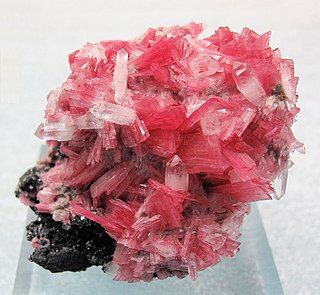
Rhodonite is a manganese inosilicate, with the formula (Mn, Fe, Mg, Ca)SiO3, and member of the pyroxenoid group of minerals, crystallizing in the triclinic system. It commonly occurs as cleavable to compact masses with a rose-red color (its name comes from Ancient Greek ῥόδον (rhódon) 'rose'), often tending to brown due to surface oxidation. The rose-red hue is caused by the manganese cation (Mn2+).
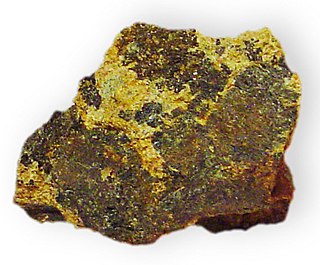
Cummingtonite is a metamorphic amphibole with the chemical composition (Mg,Fe2+
)
2(Mg,Fe2+
)
5Si
8O
22(OH)
2, magnesium iron silicate hydroxide.

Hausmannite is a complex oxide, or a mixed oxide, of manganese containing both di- and tri-valent manganese. Its chemical formula can be represented as MnIIMnIII2O4, or more simply noted as MnO·Mn2O3, or Mn3O4, as commonly done for magnetite, the corresponding iron oxide. It belongs to the spinel group and forms tetragonal crystals. Hausmannite is a brown to black metallic mineral with Mohs hardness of 5.5 and a specific gravity of 4.8.
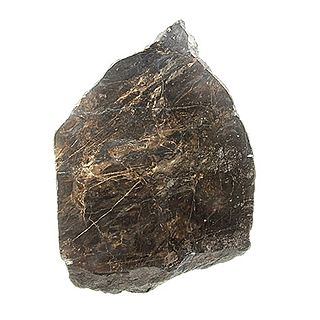
Galaxite, also known as 'mangan-spinel' is an isometric mineral belonging to the spinel group of oxides with the ideal chemical formula Mn2+Al2O4.
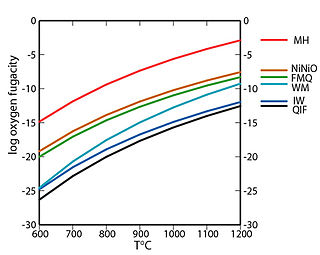
In geology, a redox buffer is an assemblage of minerals or compounds that constrains oxygen fugacity as a function of temperature. Knowledge of the redox conditions (or equivalently, oxygen fugacities) at which a rock forms and evolves can be important for interpreting the rock history. Iron, sulfur, and manganese are three of the relatively abundant elements in the Earth's crust that occur in more than one oxidation state. For instance, iron, the fourth most abundant element in the crust, exists as native iron, ferrous iron (Fe2+), and ferric iron (Fe3+). The redox state of a rock affects the relative proportions of the oxidation states of these elements and hence may determine both the minerals present and their compositions. If a rock contains pure minerals that constitute a redox buffer, then the oxygen fugacity of equilibration is defined by one of the curves in the accompanying fugacity-temperature diagram.

Cafetite is a rare titanium oxide mineral with formula (Ca,Mg)(Fe,Al)
2Ti
4O
12·4(H
2O). It is named for its composition, Ca-Fe-Ti.

Portlandite is a hydroxide-bearing mineral typically included in the oxide mineral class. It is the naturally occurring form of calcium hydroxide (Ca(OH)2) and the calcium analogue of brucite (Mg(OH)2).
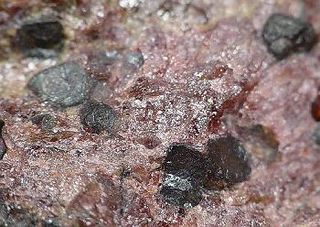
Manganosite is a rare mineral composed of manganese(II) oxide MnO. It was first described in 1817 for an occurrence in the Harz Mountains, Saxony-Anhalt, Germany. It has also been reported from Langban and Nordmark, Sweden and at Franklin Furnace, New Jersey. It also occurs in Japan, Kyrgyzstan and Burkina Faso.

Canavesite, Mg2(HBO3)(CO3)∙5H2O, is a rare carboborate mineral from the abandoned Brosso mine in Italy. Canavesite is a secondary mineral that occurs due to the weathering of ludwigite-magnetite skarn on the surface of mine walls. The physical properties consist of milky-white rosette-like aggregates of elongated transparent fibers shown in figure one. It has the crystal symmetry of a monoclinic with a diffraction symbol of 2/mP-/-.
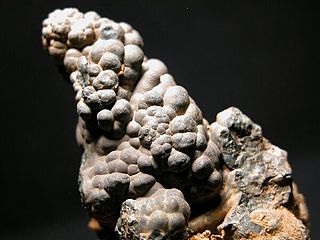
Cryptomelane (K(Mn4+,Mn2+)8O16) is the potassium endmember of the hollandite group, a family of tectomanganates with a 2 x 2 tunnel structure.

Sarkinite, synonymous with chondrarsenite and polyarsenite, is a mineral with formula Mn2(AsO4)(OH). The mineral is named for the Greek word σάρκιυος, meaning made of flesh, for its red color and greasy luster. The mineral was first noted in Sweden in 1865 as chondrarsenite, though not identified as sarkinite until 1885.
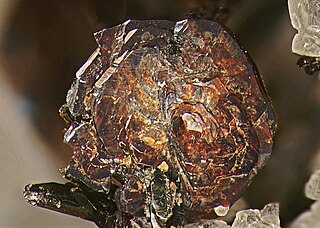
Pyrophanite is a manganese titanium oxide mineral with formula: MnTiO3. It is a member of the ilmenite group. It is a deep red to greenish black mineral which crystallizes in the trigonal system.
Chvaleticeite is a monoclinic hexahydrite manganese magnesium sulfate mineral with formula: (Mn2+, Mg)[SO4]·6(H2O). It occurs in the oxidized zone of manganese silicate deposits with pyrite and rhodochrosite that have undergone regional and contact metamorphism. It is defined as the manganese dominant member of the hexahydrite group.




















